OnePlus One Review
The OnePlus One has an off-contract price starting at only $299, but don’t call this smartphone cheap. Hiding behind the OnePlus One’s 5.5-inch HD screen is some high-end hardware.
Why you can trust Tom's Hardware
Results: CPU Core Benchmarks
AnTuTu X
AnTuTu is an Android system benchmark designed to test the performance capabilities of four major aspects of mobile devices: Graphics (encompassing 2D, UI and basic 3D), CPU (fixed, floating-point, and threading), RAM (read and write), and I/O (read and write).
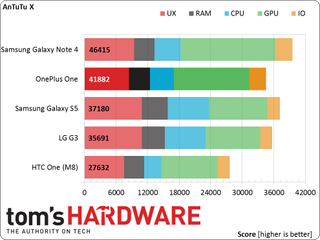
The results for AnTuTu X are sorted based on the overall scores, which are the values shown within the left end of each bar. The overall score is not simply a cumulative value based on the individual test scores. Instead, it’s a separate calculation with its own distinct value. This is why the length of the bars don’t correlate with the overall score.
In this system level benchmark, the OnePlus One posts a higher overall score than the Samsung Galaxy S5, LG G3, and HTC One (M8).
Looking more closely shows the Galaxy S5 and LG G3 with a performance advantage in the UX, RAM, and CPU tests. All three of these tests stress multithreaded CPU performance to various degrees. It will be interesting to see if the multi-core CPU test in Geekbench 3 Pro also shows a decrease in performance.
While the CPU scores were a bit low, the OnePlus One redeems itself in the GPU test, scoring 30% better than the Galaxy S5 despite having the same GPU and clock speed. The OnePlus One also compares favorably to the Galaxy Note 4 in every test except GPU, where the Adreno 420 easily outpaces the older Adreno 330 in the OnePlus One.
Basemark OS II Full (Anti-Detection)
Basemark OS II is an all-in-one tool designed for measuring overall performance of mobile devices. It scores each device in four main categories: System, Memory, Graphics and Web. The System score reflects CPU and memory performance, specifically testing integer and floating-point math, along with single- and multi-core CPU image processing using a 2048x2048-pixel, 32-bit image. Measuring the transfer rate of the internal NAND storage (Memory) is done by reading and writing files with a fixed size, files varying from 65KB to 16MB, and files in a fragmented memory scenario. Calculating the Graphics score involves mixing 2D/3D graphics inside the same scene, applying several pixel shader effects, and displaying 100 particles with a single draw call to test GPU vertex operations. The benchmark is rendered at 1920x1080 off-screen 100 times before being displayed on-screen. Finally, the Web score stresses the CPU by performing 3D transformations and object resizing with CSS, and also includes an HTML5 Canvas particle physics test.
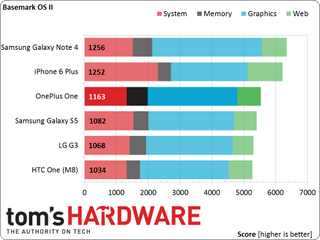
The overall score for the four Snapdragon 801 based devices all fall within 12% of each other, with the OnePlus One and HTC One (M8) bracketing the results. Notably, the Toshiba NAND in the OnePlus One delivers the best Memory score, and once again the One stands above the Snapdragon 801 crew in graphics performance, if only by a very small margin.
Geekbench 3 Pro (Anti-Detection)
Primate Labs' Geekbench offers a wide selection of cross-platform compatibility, with apps available for Windows, OS X, Linux, iOS and Android. This simple system benchmark produces two sets of scores: single- and multi-threaded. For each, it runs a series of tests in three categories: Integer, Floating Point, and Memory. The individual results are used to calculate category scores, which, in turn, generate overall Geekbench scores.

The OnePlus One, LG G3, and Galaxy S5 post nearly identical scores in both the Integer and Floating Point tests, with the OnePlus One pulling ahead in the Memory test. The Galaxy S5 actually posts the lowest Memory score despite using the same Elpida LPDDR3 RAM as the HTC One (M8). The lower clocked HTC One (M8) predictively trails the other Snapdragon 801 devices.
With its newer Snapdragon 805 SoC, the Note 4 scores higher than the One in every test, but not by much—its advantage hovering around 10%.
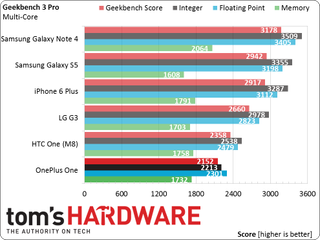
The dual-core iPhone 6 Plus falls prey to the quad-core Samsung devices. While the OnePlus One performs as expected in the single-core test, it doesn’t keep pace when all four cores are pressed into service, just like we saw in AnTuTu X. We confirmed these results by running the multi-core test on a second OnePlus One running the same software build (CM11.0-XNPH38R/Android 4.4.4). When using an earlier software release (CM11.0-KVT48L/Android 4.4.2), this second phone produced higher scores that were equivalent to the LG G3, so this anomaly appears to be a software issue. Curiously, we saw a similar problem with multi-core CPU performance in our Oppo N1 review when it was running ColorOS, but not when running CyanogenMod 10. We asked OnePlus for an explanation of this issue, but didn't receive a response.
Ed. note: After finishing our benchmarks, OnePlus released another new software update (CM11.0-XNPH44S/Android 4.4.4). We reran the Geekbench 3 Multi-Core test with this new build and saw the Geekbench Score increase to 2325, Integer increase to 2501, and Floating Point increase to 2483. These scores are equivalent to the lower clocked One (M8), so the OnePlus One's multi-core CPU performance still isn't on par with its peers.
MobileXPRT 2013
Principled Technologies' MobileXPRT 2013 is a modern SoC benchmark for Android. It consists of 10 real-world test scenarios split into two categories of testing: Performance and User Experience. The Performance suite contains five tests: Apply Photo Effects, Create Photo Collages, Create Slideshow, Encrypt Personal Content, and Detect Faces to Organize Photos. Performance results are measured in seconds. The User Experience suite also has five tests: List Scroll, Grid Scroll, Gallery Scroll, Browser Scroll, and Zoom and Pinch. These results are measured in frames per second. The category scores are generated by taking a geometric mean of the ratio between a calibrated machine (Motorola's Droid Razr M) and the test device for each subtest.
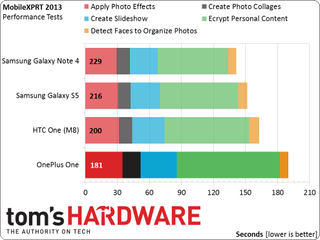
The OnePlus One falls behind the Galaxy S5 by 19% overall, even falling behind the HTC One (M8). This is surprising considering this test isn’t heavily multithreaded and the One’s good performance in other single-core CPU benchmarks.
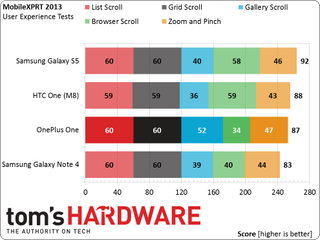
The Galaxy Note 4 lags behind in the User Experience Tests even though it has the fastest SoC. The OnePlus One performs well except for a dip in Browser Scroll performance. Still, the overall spread between all four devices is only 11%.
Current page: Results: CPU Core Benchmarks
Prev Page How We Tested Next Page Results: HTML5 And JavaScript BenchmarksStay on the Cutting Edge
Join the experts who read Tom's Hardware for the inside track on enthusiast PC tech news — and have for over 25 years. We'll send breaking news and in-depth reviews of CPUs, GPUs, AI, maker hardware and more straight to your inbox.

EKWB issues public apology regarding delayed payments — promises employees and suppliers it will change its ways

Noctua releases low-profile CPU coolers for SFF builds - NH-L12Sx77 has better clearance for RAM, VRM heatsinks

Chinese may be evading Nvidia GPU sanctions with Dell, Gigabyte, and Supermicro servers: Report
-
MrEssesse You forgot to mention how the iphone 6 plus costs 299 $ with a 2 year contract, unlocked its around 700 $.Reply -
Mike Coberly So the device itself supports the CDMA bands, but is not compatible with one of the major CDMA carriers here in the US? What a shame. :( This could easily replace my now aging Galaxy Note 3.Reply -
Memory Ever Summary is all kind of noise voice out because it's a China phone.Reply
If this is a phone from Apple, people will only ask when they can buy it. They don't real care about of the specification.
This is the different. -
house70 Got one for my wife, she loves it, esp. that she doesn't have to keep an eye on the battery icon anymore. This thing will run forever... Getting another one for myself.Reply
For about USD 350 you can't really do any better. They could sell it for 550-600, but they won't.
CM12 (Lollipop- based) is around the corner.
Only thing they botched really big was the sales; this phone had a huge potential to when first launched, but making it almost impossible to buy doesn't help. -
uplink-svk As owner of three 1+1 phones I'm heavily dissapointed with this phone. I really loved the Crysis Music trailer, and there I decided to go for this phone.Reply
Things that really dissapointed me are:
- display is yellowish, at least was on all three pieces I owned
- it's made out of cheap plastics, I don't care it feels "great", I wanted metalic phone, like they said it's gonna be in the beginning
- one of the pieces was doing purplish photos
- it's way too big
- CM is fine, but still misses some of the basic features offered by 3rd party GUi from Samsung/HTC, which are in my eyes normal - RMAing the 1+1 is a hell, You need to send it back, wait and stuff, thank You, but no
In general I bought the first one for 290 euro, second one for 250 euro, and third one for 390 euro, which are pretty good prices in my country for these phones, and all were a disaster :\ -
rexter This is what Nexus 6 should have been - price-wise. Watch out Google here's OnePlus. Too bad, you'll need an invitation to get one, why not invite me instead if I give them my e-mail; this just show that the company don't have much stocks to share to every, I suppose? and that pink wall paper reminds me of Ubuntu. I like the black one if I can get my hands on one... or two.Reply -
Karksken Can you use this one as phone too or is it just a tablet(review). Smartguys please give us on smartPHONES also the real info as Phone quality, connection quality, e.a. info when you get the out of memory error when there is still a lot of mem available and you SIM is disconnected. How does the apps interact with the phone part.Reply -
D A The invites are easy to get with a little patience. I just bought three of them in the last tow weeks. All my invites I got where from google + where previous buyers are giving out the invites hourly. Jut go onto Google plus and do a search for "Oneplus Invite", then click "MOST RECENT". be patient and keep refreshing and be ready to respond to a post where someone is offering an invite... respond with your email address that you would like one. I did this for all three of my invites, there was only one person that did not send me the invite. I was able to get all the invites within an hour.Reply